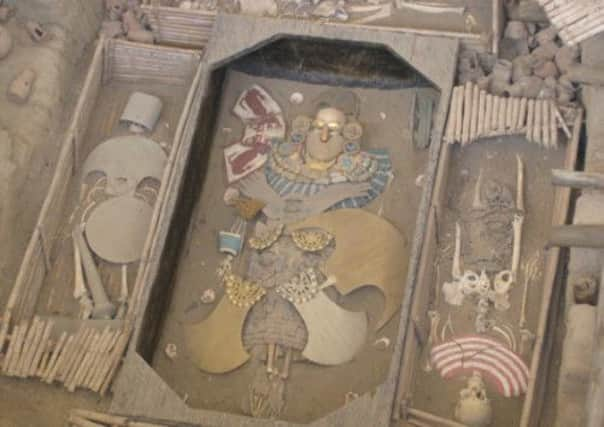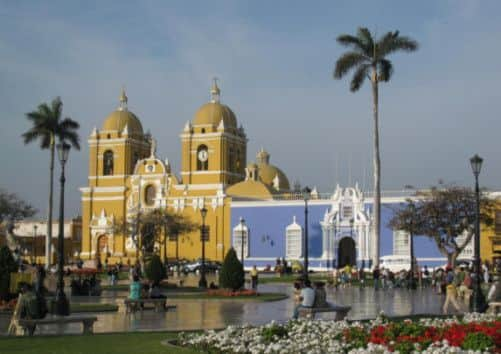Travel: Peru’s natural and archaeological wonders


I was soon engrossed by this moody tale of mysterious archaeology set on a dark and distant planet. Two days later a flash of déjà vu struck me as I entered the alien world of the Temple of the Moon, one of the chief ceremonial sites of the ancient Moche civilization that thrived in Peru’s northern deserts 1,500 years ago. Prometheus has its fair share of spine-chilling moments but nothing quite prepared me for the Sacrificial Pit, the first area you encounter in this magnificent adobe brick temple. In jolly, matter-of-fact terms my guide described how warriors fought ceremonial battles in which the losers were presented to priests for ritual sacrifice.
After having their throats cut, blood drained and flesh stripped, their skeletons were very likely used as puppets in religious ceremonies. At this point my head started reeling and, glancing round, I spotted a viringo, a Peruvian hairless dog curled up in the corner. These extraordinary dogs resemble long-legged chihuahuas and were prized companions of the Inca nobility. You’ll find them in tourist sites all over Peru where they’re kept as pets. Perhaps sensing my squeamishness he got up and walked over to nuzzle my legs. At the same moment a couple of workmen switched on a radio and began to sing along to a cheerful salsa song, lightening my mood no end and saving me from the indignity of fainting in the Sacrificial Pit.
Advertisement
Hide AdMost tourists visiting Peru make a beeline for the magnificent Andean ruins of Machu Picchu but in many respects, the sites of the northern deserts offer far more to archaeology enthusiasts. The humid mountain climate has destroyed any frescoes that Machu Picchu once had, whereas the arid desert air has beautifully preserved much of the northern temples’ decorative plasterwork.


From the Sacrificial Pit I entered the inner sanctuaries of The Temple of the Moon, a multi-coloured world of unfathomable mythology. Hard to avoid is the Moche’s supreme deity Al Apaec, the Great Decapitator. His fearsome fanged face stares out of beautifully patterned rhomboid panels while other depictions show him carrying human heads. I was far more captivated by the sacred animals: jaguars, spiders, sea otters and stingrays that cover the walls in beautiful stylised bands. A recently unearthed panel depicts detailed stories of battles and ceremonies in which, if you look carefully, you can spot a man wearing what uncannily resembles a European crown centuries before the Spanish arrived in South America.
Exploring equatorial deserts might seem like a hot and exhausting business but the climate in northern Peru is in fact a delight. This is due to the freezing Pacific Humboldt Current which sends blasts of natural air conditioning into the desert. Temperatures rarely rise above 23C and Trujillo, the charming colonial town where most tourists base themselves is justifiably known as The City of Eternal Spring.
The nearby seaside resort of Huanchaco is a great place to stop for lunch and the seafront is lined with excellent restaurants, ideal places to sample Peru’s renowned cuisine which is among the best in South America. At the incongruously named Big Ben I ordered causa, a delicious savoury cake made of layers of mashed potato and avocado followed by Arroz con Marisco, a fragrantly spiced paella. After lunch I took a stroll along the beach which is lined with elegant curved reed boats, identical to those depicted in ancient Moche frescos. A fisherman was unloading a net of crabs and a hungry looking pelican was standing next to him on the sand. Suddenly a small yapping dog appeared out of nowhere and in a scene worthy of Benny Hill began chasing the poor waddling pelican along the beach pursued by a group of laughing toddlers.
In recent years, archaeological excavations in Peru’s deserts have yielded treasures unparalleled since the discovery of Tutankhamun. One of the most recent finds occured in 2006 when the Lady of Cao, a Moche queen was uncovered complete with an exquisite gilt copper crown and intricate zoomorphic gold jewellery. Her mummified body, covered in sinister-looking spider tattoos is displayed in a world-class museum built next to the adobe brick pyramid where she was discovered. One of the things you’ll encounter in northern Peru is curious children who rarely see foreigners. As I was looking at The Lady of Cao floating eerily above her treasure in an elevated blue-lit display case I was startled when I looked round to see about 20 wide-eyed primary school children staring at me in fascination, rather than at this extraordinary mummy.
From northern Peru’s dusty capital Chiclayo, I travelled by night bus up to the beautiful Andean town of Chachapoyas at the heart of some of the best hiking country in Peru. After a late breakfast in the beautiful riverside gardens of Casa Andina Lodge, I was picked up by my local guide Jose for a hike to the nearby rock tombs of Karajia. At the tiny village of Caseria Cruz Pata we were greeted by a group of smiling women sitting on their doorsteps gossiping and spinning wool on long spindles. In the fields behind their houses, their menfolk were busy ploughing fields with oxen and handheld yokes and gave us a wave as we walked by.
Advertisement
Hide AdDuring the hike I was initiated into the delights of twitching. On the dusty highway we’d passed a group of silver-bearded birdwatchers in safari suits standing motionless by the side of the road as they stared through binoculars at a circling falcon. A flash of yellow in the undergrowth had Jose reaching into his daypack for the bible of Peruvian bird-watching, Princeton University’s beautifully illustrated Birds of Peru. It turned out to be a flycatcher and I was soon transfixed by iridescent hummingbirds and bright blue tanagers flitting through the treetops. I could fully understand why Peru is considered one of the Holy Grails of the globetrotting birdwatching fraternity.
An hour later we turned a corner and there above us on a dramatic cliff face stood six ancient human-shaped sarcophagi, two of them topped by skulls, their ghostly faces staring eastwards towards the rising sun. It was an awe-inspiring sight and looking up at the tombs I wondered why I’d never heard of this magnificent place before, but that’s the beauty of northern Peru; remote, mysterious and always thought-provoking, few places on earth can match it for such astonishing surprises.
Advertisement
Hide AdTHE FACTS Journey Latin America specialises in tailor-made holidays and tours to Latin America and Antarctica. Their 13 day Northern Peru Holiday visiting Chan Chan, the treasures of Sipan, Chachapoyas and Kuelap costs from £2,782 per person. This price includes flights from London, transfers, excursions and breakfast daily. For further information contact Journey Latin America (www.journeylatinamerica.co.uk). Air France (www.airfrance.co.uk) offers a choice of 15 UK and Irish departure points including Aberdeen, Dundee, Edinburgh and Glasgow. Fares from Edinburgh to Lima, via Paris Charles de Gaulle, start from around £572 return.